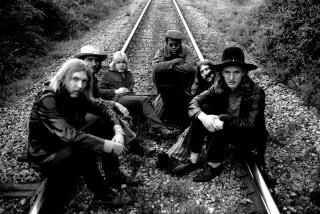Al Green’s Compelling ‘Right Stuff’
- Share via
The most satisfying and usually most economical way to survey an artist’s career is a box set, but what happens when an artist whose music you want doesn’t have one out?
In the case of Al Green, the most compelling of all post-’60s soul singers, you can turn to some greatest-hits packages or--better yet--his original albums, the first four of which have been released on CD by Capitol Records as part of its “The Right Stuff” mid-line budget series.
The albums, which carry an $11.98 list price, include the artwork and music from Green’s original Hi Records albums, plus new liner notes.
Don’t worry when you look at the backs of the albums and see a lot of song titles that are either unfamiliar or that are associated with other artists.
Whether the song is the Bee Gees’ “How Can You Mend a Broken Heart” or a tune that’s new to you, Green’s interpretation generally offers the sensual tension and dramatic intimacy that characterizes his most celebrated hits.
Born in Forrest City, Ark., in 1946, Green (his real name is Greene) began singing in a gospel quartet when he was still in his early teens.
By the time Memphis record producer Willie Mitchell spotted him singing in a Texas club in 1968, Green had switched to secular music and had registered a Top 50 hit, “Back Up Train,” on tiny Hot Line Records.
Mitchell took Green to Memphis where he signed with Hi Records and began working with the Hi house band, which ranks with the great Stax/Volt session groups.
“Green Is Blues,” his first Hi album, didn’t generate any hits, but it offers a rewarding chronicle of a young singer trying to find a comfortable style. The eclectic material on the 1970 package ranges from Jerry Butler’s “I Stand Accused” and Lennon-McCartney’s “Get Back” to Heyward-Gershwin’s “Summertime.”
“Al Green Gets Next to You,” which followed in 1971, is a more confident and commanding work in which Green goes the Temptations one step further in his rendition of “I Can’t Get Next to You” and then marches to stardom with one of the great soul singles ever: “Tired of Being Alone.” The weak moment: an unconvincing version of the Doors’ “Light My Fire.”
By the time Green’s “Let’s Stay Together” was released in 1972, the young singer was widely heralded as the successor to Sam Cooke and Otis Redding’s soul crown. The album’s title song went to No. 1 on the pop and R&B; charts.
The title track from Green’s other 1972 album, “I’m Still in Love With You,” was also a Top 10 hit, and it was backed by another group of well-chosen and marvelously performed songs, including Kris Kristofferson’s “For the Good Times.”
Green, an ordained minister who has spent most of his time since the late ‘70s in gospel music, remains one of the great voices in modern pop. He returned to the pop charts in 1988 with his duet with Annie Lennox on “Put a Little Love in Your Heart,” and teams with Lyle Lovett on Willie Nelson’s “Funny How Time Slips Away” on a soul-meets-country collection of duets that will be released this spring by MCA Records.
More to Read
The biggest entertainment stories
Get our big stories about Hollywood, film, television, music, arts, culture and more right in your inbox as soon as they publish.
You may occasionally receive promotional content from the Los Angeles Times.










